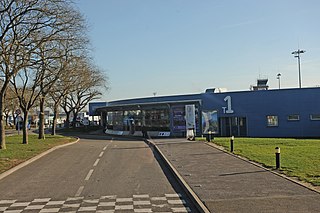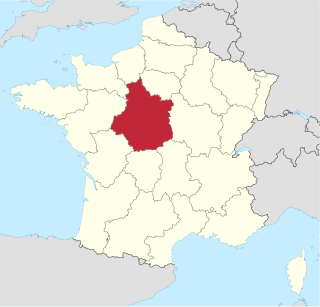
Beauvais–Tillé Airport, branded as Paris-Beauvais Airport, is an international airport near the city of Beauvais in the commune of Tillé in France. In 2016, it was the tenth busiest airport in France, handling 3,997,856 passengers, and is mostly used by charter and low-cost airlines.

Laon-Couvron Air Base is a former French and United States Air Force base in France. It is located in the Aisne département of France, less than one mile southeast of the village of Couvron and 6 miles northwest of Laon; on the southwest side of the Autoroute des Anglais 1 Mile (1.6 km) east of the village of Couvron-et-Aumencourt.

Chièvres Air Base, also referred to as SHAPE Airfield at Chievres Air Base, is a NATO airfield operated by the United States Air Force. It is located 1 nautical mile east southeast of the Walloon town of Chièvres in the province of Hainaut, Belgium and about 12 mi (19 km) from Headquarters, Supreme Headquarters Allied Powers Europe (SHAPE), in Casteau. It is mainly used to provide logistic support to NATO and SHAPE. Infrastructure support is provided by the United States Army Garrison Benelux for NATO.
Saint-Dizier-Robinson Air Base is a front-line French Air and Space Force fighter aircraft base located approximately 4 km west of Saint-Dizier, in the Haute-Marne department of the Champagne-Ardenne region in northeastern France.

Saint-Simon – Clastres Air Base is an abandoned military airfield, which is located approximately 3 km (2 NM) northwest of Clastres and east of Saint-Simon, both communes in the Aisne department of the Picardy (Picardie) region in France. It is approximately 116 km (63 NM) north-northeast of Paris.

Chartres – Champhol Aerodrome is an airport serving Chartres and Champhol, in the Eure-et-Loir department in north-central France. The airport is located 2.5 km (1.3 NM) east-northeast of Chartres and it is southeast of Champhol. It supports general aviation with no commercial airline service scheduled.
Châteaudun Air Base was a French Air Force (French: Armée de l'Air base, between 1934 and 2014. The base was located approximately 3.5 kilometres southeast of Châteaudun and about 112 kilometres southwest of Paris. It is currently an airfield attached to Orléans – Bricy Air Base.

Brétigny-sur-Orge Air Base is a former French Air Force French: Armée de l'Air (ALA) base. The base is located approximately 2 miles (3.2 km) southeast of Brétigny-sur-Orge; about 17 miles (27 km) south of Paris.

Orléans – Bricy Air Base is a French Air and Space Force (ALAE) base. The base is located approximately 6 miles (9.7 km) north-northwesst of Ingré near the city of Orléans; about 65 miles (105 km) south-southwest of Paris, France.
Vitry-en-Artois Airfield is a regional airfield in France, located 1 mile (1.6 km) northeast of Vitry-en-Artois; 105 miles (169 km) north-northeast of Paris. It supports general aviation with no commercial airline service scheduled.
Juvincourt Airfield is an abandoned military airfield, which is located near the commune of Juvincourt-et-Damary in the Aisne department of northern France.
Melun Villaroche Aerodrome is an aerodrome located 8.5 km (4.6 NM) north of Melun, a commune in the Seine-et-Marne department in the Île-de-France region in north-central France.
Coulommiers – Voisins Aerodrome is an airport serving Coulommiers in France. It is located in the Seine-et-Marne department, 5 km (2.7 NM) west-northwest of Coulommiers. It is also 34 miles (55 km) east of Paris.

Pontoise Aerodrome or Pontoise – Cormeilles Aerodrome is an airport located 7 km (3.8 NM) northwest of Pontoise in Boissy l'Aillerie near Cormeilles-en-Vexin, all communes of the Val-d'Oise department in the Île-de-France region in northern France. The airport is also located 16 miles (26 km) northwest of Paris.

Péronne-St Quentin Airfield is a recreational aerodrome in France, located 11 miles (18 km) west of Saint-Quentin; 121 miles (195 km) north of Paris. It supports general aviation with no commercial airline service scheduled.

Cambrai-Niergnies Airport is a regional airport in France, located 3 miles (4.8 km) south-southeast of Cambrai; 100 miles (160 km) north-northeast of Paris.
Giebelstadt Army Airfield is a closed military airfield located in Germany, southwest of Giebelstadt in Bavaria, approximately 250 miles southwest of Berlin. It was turned over to the German government on 23 June 2006 and is now Giebelstadt Airport, a general aviation airport.
Münster-Handorf Airfield is a former military airfield located in Germany about 5 miles east-northeast of Münster (Nordrhein-Westfalen); approximately 250 miles west of Berlin.
Saint-André-de-l'Eure Airfield is a recreational aerodrome in France, located about 10 miles southwest of Évreux (Normandy). It supports general aviation with no commercial airline service scheduled.

Celone/San Nicola d'Arpi Airfield is an abandoned World War II military airfield in Italy. It was located 10 kilometers north of Foggia, in the Province of Foggia. The airfield was abandoned and dismantled after the end of the war in 1945.














